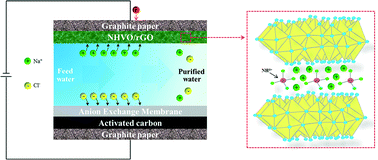NH4V4O10/rGO Composite as a high-performance electrode material for hybrid capacitive deionization†
Abstract
Capacitive deionization (CDI) has developed rapidly due to its advantages of low energy consumption and eco-friendliness. In recent years, many researchers have devoted their efforts to fabricating new electrode materials in order to achieve superior desalination efficiency and excellent long-term recycling stability. Herein, a new CDI cathode material — an NH4V4O10/rGO (NHVO/rGO) composite — was synthesized using a simple hydrothermal process. The as-prepared ammonium vanadium bronze NH4V4O10 (NHVO) displayed a large 2D layer spacing, of about 1.0 nm, and was hence tested as a potential Na+-intercalating material. The graphene present in the composite played a significant role in improving the electrical conductivity of NHVO, greatly promoting its desalting efficiency. During desalination tests, an NHVO/rGO-based CDI system delivered a NaCl removal capacity of 20.1 mg g−1 at an applied voltage of 1.2 V in a 500 mg L−1 NaCl solution; that is, the NHVO/rGO composite displayed a remarkable salt removal performance. Due to the excellent desalination performance of this system, the NH4V4O10/rGO composite is expected to become an appealing candidate for enhancing the performance of CDI electrodes.

- This article is part of the themed collections: Environmental Science: Water Research & Technology Cover Art and Capacitive deionisation and electrosorption 2020


 Please wait while we load your content...
Please wait while we load your content...